
 |
|
|
#1 |
|
Member
Join Date: Dec 2004
Location: Sweden
Posts: 1,637
|
Just received this sword/parang/sabre/golok.
This is obviously European inspired but was it made for Europeans/Dutch or local Sundanese use? Michael |
|
|

|
|
|
#2 |
|
Member
Join Date: Dec 2004
Location: What is still UK
Posts: 5,807
|
It looks 100% Dutch to me, quite handsome. Tim
|
|
|

|
|
|
#3 |
|
(deceased)
Join Date: Dec 2004
Location: East Coast USA
Posts: 3,191
|
Hi VVV
I can definately say it's a Indonesian sword made for the Dutch East Indies Company. I have a spear point Bowie/Hunting knife and it is marked identically as yours but with a 1907 date. I will post a picture of it when I get home tonight. By the way your sword is lovely and is an excellent quality example infact I think the same smith made both yours and mine. Lew |
|
|

|
|
|
#4 |
|
Vikingsword Staff
Join Date: Dec 2004
Location: The Aussie Bush
Posts: 4,209
|
This is an example of Dutch Colonial swords made in western Java, mostly in Tjikeroeh, during the period from about 1890 to 1920. [This style of blade is similar to a Dutch military saber from the same period -- I will post pictures in the next day or so (the clipped point is very similar).]
The broad fuller and foliate engravings are characteristic of this style. Hilts have full length tangs, secured with a threaded nut at the end. Handles tend to be bone or antler with a brass guard and ferrules. Scabbards are plain, with black wood and brass accents at the throat and toe. Here is another, slightly different example: 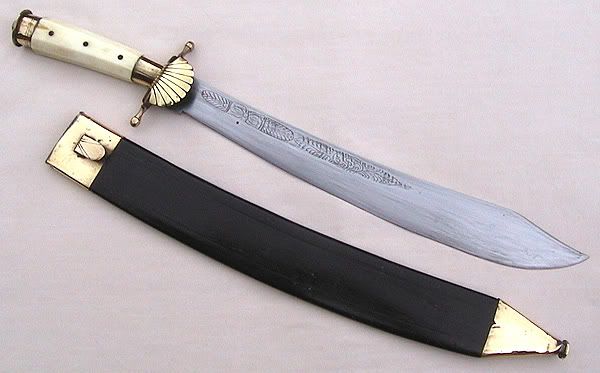 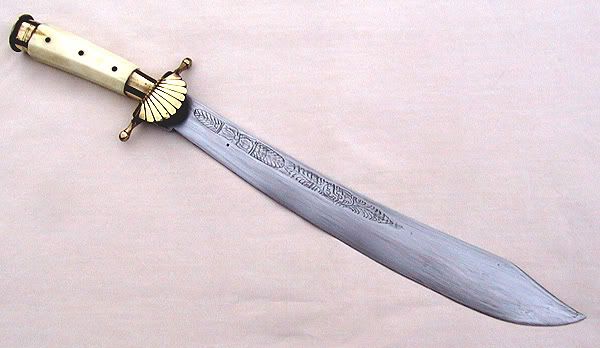 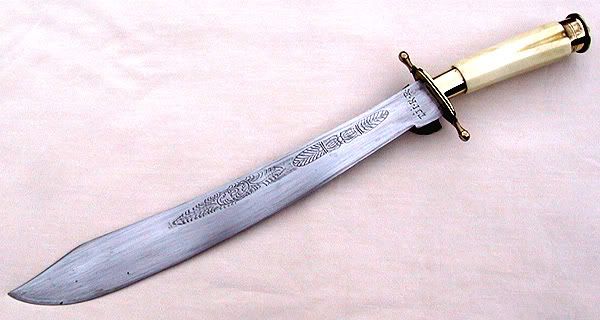 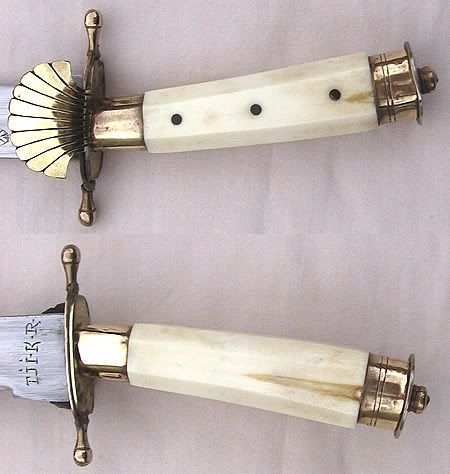  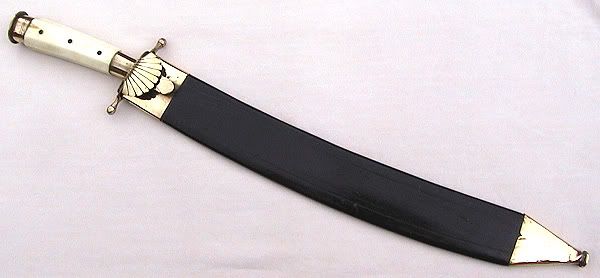 Ian. |
|
|

|
|
|
#5 |
|
Vikingsword Staff
Join Date: Dec 2004
Location: The Aussie Bush
Posts: 4,209
|
Here are two old threads that discussed these swords -- several pictures included. I have attached pictures of two more that I have.
http://www.vikingsword.com/ubb/Forum1/HTML/001139.html http://www.vikingsword.com/ubb/Forum1/HTML/002112.html 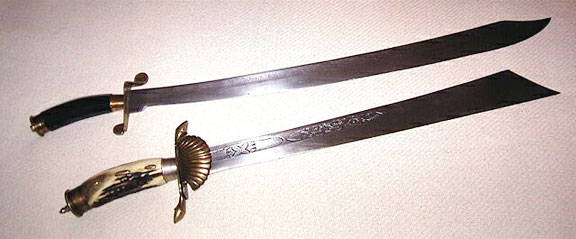 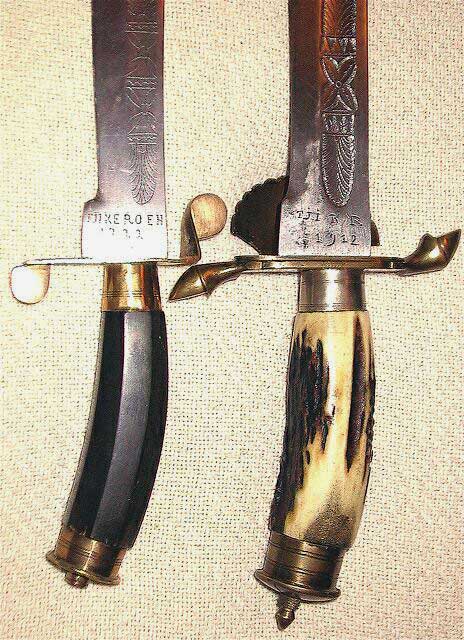 Ian. Last edited by Ian; 7th July 2005 at 09:57 PM. |
|
|

|
|
|
#6 |
|
Vikingsword Staff
Join Date: Nov 2004
Posts: 6,294
|
East gets mistaken for West .
I'm not 100% positive on this example ; but you can see the similarities to Tjikeroeh and Philippine knives . http://cgi.ebay.com/ws/eBayISAPI.dll...542483831&rd=1 |
|
|

|
|
|
#7 |
|
Member
Join Date: Dec 2004
Location: Sweden
Posts: 1,637
|
Thanks all for the comments and to get the background confirmed from more knowledgeable forumites.
Look forward to see pics of your examples and thanks also for the links to the older threads. Michael |
|
|

|
|
|
#8 |
|
Vikingsword Staff
Join Date: Nov 2004
Posts: 6,294
|
Here's my example complete with battle scars .
Golok . |
|
|

|
|
|
#9 |
|
Member
Join Date: Dec 2004
Location: What is still UK
Posts: 5,807
|
I have found this thread very interesting. It is shows the spread of decorative motifs through Malaysia and Indonesia. Untill now I had a feeling because of the decoration, that this was a tourist golok even though it had been used. I only post a picture to compare the shift in style. Tim
|
|
|

|
|
|
#10 |
|
Member
Join Date: Feb 2007
Posts: 1
|
Just looking on you form I have a sword just like VVVs, Can you tell me where I can get it valued or would someone have some idea of it value.
|
|
|

|
|
|
#11 | |
|
Member
Join Date: Feb 2007
Location: Kaboejoetan Galoenggoeng Mélben
Posts: 460
|
Hello everybody,
 Quote:
How sure are you about the beginning period? I am told that there is a similar klewang with 1773 stamped on the blade. Regards. |
|
|
|

|
|
|
#12 |
|
Member
Join Date: Jun 2005
Location: Tebbetts, Missouri, USA
Posts: 49
|
I drool from envy. Thank you, my friends for sharing those lovely pictures.
|
|
|

|
|
|
#13 | |
|
Vikingsword Staff
Join Date: Dec 2004
Location: The Aussie Bush
Posts: 4,209
|
Quote:
The Dutch klewang, on which the clipped-blade saber forms of these Tjikeroeh swords are based, was placed in service by the Dutch military in 1898. So it is likely that the locally copied versions post-date that time. I do think that the manufacture of European style knives and swords, with antler hilts and other "Westernized" features, arose about that time. These are among the very few swords and knives in SE Asia that actually carry a date of manufacture. I've not seen any before about 1890, and the most recent in the mid-1920s. The incising of the numbers can be rather confusing sometimes, and a 9 can be confused for a 7 on some inscriptions (one of mine shows a 9 that could easily be read as a 7). I doubt that any of these knives and swords date from the 18th C. -- they look in too good shape to be that old. Regards, Ian. |
|
|
|

|
|
|
#14 | |
|
Member
Join Date: Feb 2007
Location: Kaboejoetan Galoenggoeng Mélben
Posts: 460
|
Hello everybody,
 Quote:
Thank you very much for the information. I really appreciate it. It has made me wary.  Regards. |
|
|
|

|
|
|
#15 |
|
Member
Join Date: Nov 2006
Location: The Netherlands
Posts: 2,225
|
These Tjikeroe swords are pretty common in the Netherlands. although the quality varies. The examples placed on this site are very nice.
Personally I feel that the ones that have the western look are probably made as souvernir. mentioning a place and year is something that your normally not see on indonesian weapons. But also the more indonesian types (with wooden animal like handles) have the name and date, so probably these are also made as souvernir. I had a nice one last year, I believe it is now in Flavio's collection. |
|
|

|
|
|
#16 |
|
Member
Join Date: Dec 2004
Posts: 951
|
They both made for tourist the dutch and the javanese one that pictured here
There are special javanese ones that are not for tourist I think one was pictured in Zonneveld s Book Ben |
|
|

|
|
|
#17 | |
|
Member
Join Date: Feb 2007
Location: Kaboejoetan Galoenggoeng Mélben
Posts: 460
|
Hello everybody,
 Quote:
At the time, in Sumedang Regency (close to KNIL HQ), the adjacent villages of Tjikeroeh and Tjibatoe (NOT the Cibatu of Sukabumi/Bogor of recent fame  ) were well-known for their foundries. So one or both of them were likely to have been commissioned by KNIL to produce klewang to their specs (which may account for their European-style appearance). ) were well-known for their foundries. So one or both of them were likely to have been commissioned by KNIL to produce klewang to their specs (which may account for their European-style appearance).If such were the case, the foundries would have simply continued the VOC practice of marking these klewang with name and year. As for materials used for the handles: people of the region have traditionally been very utilitarian. Handles have been made from wood, buffalo horn, antler, etc, ... even RHINO HORN (Chinese traders dicovered this and started buying up these weapons just for the handles). Regards. |
|
|
|

|
|
|
#18 |
|
Member
Join Date: Nov 2006
Location: The Netherlands
Posts: 2,225
|
The assumption that these where produced for dutch soldiers fighting in Aceh feels very unlikely. There is a big variation in models and material.
If they were made by an order of the KNIL they would not have this model. They look more like a so-called 'hartsvanger' a sidearm that was used by hunters in the 1800's Other option would be private purchase by soldiers for use in the Aceh war. But they are always find in unused condition and also the model is something that I can not imagine being desired by dutch soldiers. I have never seen these Tjikeroe waepons on pictures of soldiers from those days. I really stick to the souvernir option. Best regards, Willem Enclosed some pictures of the one I had last year and I believ to be in Flavio's collection now. |
|
|

|
|
|
#19 | |
|
Member
Join Date: Dec 2004
Location: Italia
Posts: 1,243
|
Quote:
Yes, Willem you're right!!!!   
|
|
|
|

|
|
|
#20 |
|
Member
Join Date: Nov 2006
Location: The Netherlands
Posts: 2,225
|
PS. last weekend I saw a miniature Tjikeroeh sword.
Approx 25 cms total length. Maybe made in commssion for the smal KNIL soldiers ?  It strengthened my opnion that they are mainly tourist items. But some of them are really well made with beautifull materials as this thread clearly shows. Sure worth collecting 
|
|
|

|
|
|
#21 | |
|
Member
Join Date: Dec 2004
Location: Sweden
Posts: 1,637
|
Quote:
Here is one of mine that's 27 cm, excl. scabbard. Did it look the same? Michael |
|
|
|

|
|
|
#22 |
|
Member
Join Date: Nov 2006
Location: The Netherlands
Posts: 2,225
|
Dear Michael,
No, the 'miniature' I saw last weekend was the European style, with a bone handle and black wood plain scabbard. with metal mountings. This one is fun too. We almost have material for a 'coffeetable book' about Tjikeroeh swords 
|
|
|

|
|
|
#23 |
|
Member
Join Date: Apr 2007
Location: Wisconsin, USA
Posts: 413
|
Here is a golok from the village of Tjikeroeh in Java, Indonesia, c. late 19th - early 20th century. The overall length is 20 ½ inches. The blade length is 15 inches. The edge is recurved in shape, with a "fat belly" at the point of maximum percussion. A single large fuller is found on both sides of the blade along the spine. The fuller is decorated in an okir pattern typical of swords from Tjikeroeh and neighboring villages. The back side of the blade is slightly concave in shape with a width of ¼ inch tapering distally to the point. The blade edge smoothly curves upward to the point and the back slopes down in nearly a straight line to the point. The hilt is carved hardwood in a typical design that is representative of a parrot. There are glue indications of a relatively recent repair to the hilt. The scabbard wood is slightly different indicating that it is a replacement for the original (if any).
More pictures at http://atkinson-swords.com/collectio...ok-tjikeroeh1/ |
|
|

|
|
|
#24 |
|
Member
Join Date: Apr 2007
Location: Wisconsin, USA
Posts: 413
|
Here is an interesting example of golok sword made in the village of Tjikeroeh, Java, during Dutch Colonial times (1888 − 1920). The shape of blade is typical of Java. The guard however is probably based on Dutch hunting sword models. Nevertheless, it is not a copy of a European sword. This one, like the others of the period, are artistic interpretations that are impressed with unique Javanese design attributes. The hilt, of bone, features brass ornamentation at foot and toe with a threaded nut securing the full tang blade. The guard, also of brass, features a single rounded acorn finial and a brass clamshell, typical of European swords in this period. The style of this hilt is borrowed from Hirschfanger. The total length is 41cm, the blade alone is 29cm long. The scabbard is of leather over wood and relatively unusual.
More pictures at: http://atkinson-swords.com/collectio...ok-tjikeroeh2/ |
|
|

|
|
|
#25 |
|
Member
Join Date: Apr 2007
Location: Wisconsin, USA
Posts: 413
|
This is a heavy golok from the West Java village of Tjipatjing. It was likely made special order for a foreigner, probably a Dutch worker or soldier, who was living in what was at the time a Dutch colony. The hilt is made of bone with flat steel disk-shaped pommel that is secured by the tang with typical flattened end. The hilt including guard is 5 ⅜ inches long. The s-shaped guard, also steel, is 3 ⅛ inches wide with opposite facing quillons. The blade measures 17 inches in length along the center line. The blade is evenly 1 ¼ inch wide prior to the tip which is a drop point, having an equal convex curvature of the back and edge towards the point. There is an unsharpened false back edge. The style of this hilt is borrowed from Hirschfanger.
The thickness has a slight distal taper from ¼ inch at the base to ⅛ inch prior to the tip, measured along the top of the blade. A large fuller with okir-style engraving is found on both sides of the blade, each measuring 14 ½ inches. A second, thin fuller is found between the large one and the back edge on both sides. The name of the hamlet where this sword was created is enscribed on one side of the blade, "Tjipatjing" along with the year, 1904. More pictures at: http://atkinson-swords.com/collectio...al-tjipatjing/ |
|
|

|
|
|
#26 |
|
Member
Join Date: Apr 2007
Location: Wisconsin, USA
Posts: 413
|
This is a klewang with a European-style grip and a clamshell langet on the front of the cross guard. A klewang blade is somewhat unusual to find from this era c. 1910. The hilt is made of antler with brass pommel and finishings and is 6 inches in length (excluding clamshell). The s-shaped guard, also brass, is 4 ¾ inches wide with rounded "acorn" finials. The blade measures 21 ¼ inches in length along the bottom, 19 ½ inches along the top. Typical of klewangs, the blade broadens from 1 ⅜ inches wide at the base to 2 inches at the tip. The thickness has a slight distal taper from ¼ inch at the base to ⅜ inch at tip, measured along the top of the blade. A large fuller with okir-style engraving is found on both sides of the blade, each measuring 13 inches. The name of the hamlet where this sword was created is enscribed on one side of the blade, "Tjicatjing" along with the year, 1910.
More pictures at: http://atkinson-swords.com/collectio...onial-klewang/ |
|
|

|
|
|
#27 |
|
Member
Join Date: May 2020
Posts: 726
|
chikeru / tjikeroeh....
I do see quite a lot of threads from 2005 to 2015 some interesting, some guessing and some well...   just managed to lay my hands on 2 of them: a small and a big one First I was advised on literature: Keris Jawa (Haryoguritno) de Kris I, (Tammens), Traditional weapons from the Indonesian Archipelago (van Zonneveld), Keris Indonesia, Keris Bali (Neka) en Tafsir Keris (Bpk Junus) Tjikeroeh ( since 1972 Cikeruh in modern Bahasa Indonesia) is a dessa east of Bandung, Java where around the turn of the 20th century in the period between 1890 to 1920 production of weapons took place ,specially cold weapons. Tjikeroeh at that time, just like Ttjipatjing (Cipacin) which is closeby, famous for its production of, not only local but also western European arms like sabers, knives and daggers. A huge misunderstanding is the fact that they only produced for local KNIL ( Dutch Indies Army) or as substitute for local Dutch residents working for the railraod, government or even tourists. A huge varity from working knives like simple bado to a fancy golok, parang, european klewang and (bowie-like) knives and dagger, with handles from bone, horn or wood. Scabbard mostly (dark) wood, sometimes with copper, nicely decorated and place of manufatoring and date engraved. ( Tjikeroeh or variances like TJKRH, TJIKE, TJIKR, TJKR) Regardless the “export nature” many were very good sword, due to the use of spring steel ! Last edited by gp; 18th November 2021 at 08:49 PM. |
|
|

|
|
|
#28 |
|
Member
Join Date: May 2020
Posts: 726
|
hereby my small one, a so called hartsvanger or Hirschfänger
Totale length 26.5 cm incl scabbard knife 23.5 cm blade 14.5 cm lang 2 cm wide grip 9.5 cm ferrule 1.5cm pommel 1.5 cm bone grip 6 cm copper crossguard 6 cm scallop shell 3 cm 1.3 narrow locket 1 cm |
|
|

|
|
|
#29 |
|
Member
Join Date: May 2020
Posts: 726
|
some more
|
|
|

|
|
|
#30 |
|
Member
Join Date: May 2020
Posts: 726
|
now the bigger one
49 total, scabbard 38 cm, chape 6 cm, locket 4 cm scallop shell 4 cm 3 narrow bone grip 7.5 cm pommel 2 cm knife 42 cm blade 30.5 cm with a width of 3- 2.5 - 4 cm drawing on the blade : 7.5 and 6 cm, reverse side 8 en 7 cm |
|
|

|
 |
|
|